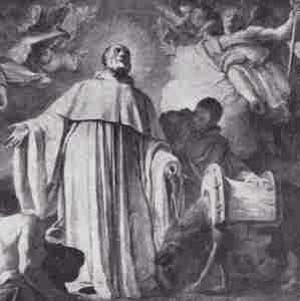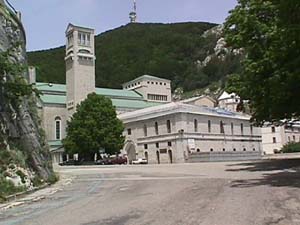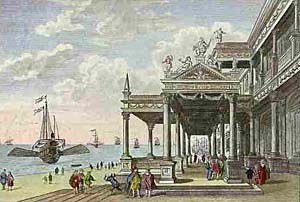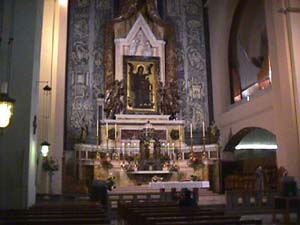 |
The Saint of the Day
St. William of Vercelli – June 25
Prof. Plinio Corrêa de Oliveira
Biographical selection:
St. William was born in 1085 at Vercelli in the Piedmont region of Italy of noble and wealthy parents. When he was still very young, he determined to renounce the world and become a hermit.

St. William of Vercelli,
hermit, Abbot, adviser to a King
|
He built his first hermit’s hut on Monte Solicoli, and then went to Monte Vergine. Many disciples came to him there, attracted by the sanctity of his life and many miracles he performed. Soon a community formed, of which he became the Abbot, and a church to Our Lady was built at the site. For this reason, the mountain became known as Monte Vergine [the Mount of the Virgin].
After a while, however, the monks began to complain that St. William’s rule was too strict and life too austere. He therefore decided to leave Monte Vergine. He went to Southern Italy and founded a new hermitage on Monte Laceno, then others at Basilicata, Conza, Guglietto, and Salerno. He also became an adviser to King Roger I of Naples. St. William died at Guglietto on June 25, 1142.
The first congregation of Monte Vergine dissolved. The monastery, however, remained and came into the hands of the religious of Our Lady of Monte Cassino, who wear the white habit of St. William to remember the founder of the monastery.

The Monastery of Monte Vergine today
|
The following extraordinary fact is recorded about the Monte Vergine monastery, where the monks still lead a life of penance and austerity. According to the rule, it is not permitted to eat meat, eggs, milk, or cheese. If someone tried to violate this regulation, storm clouds would appear in the sky and the lightning would destroy the illicit foodstuff that had been brought into the monastery.
Something similar was recorded at the Camaldula of St. Romualdo. If someone tried to bring food not permitted by the rule into the hermitage, it would quickly become corrupted and infested with worms.
This happened on many occasions, and always with the same result. It is the way God chose to show that He desires the traditions of penance and austerity of the great St. William, as well as St. Romualdo, to be maintained.
Comments of Prof. Plinio:
This selection shows how beautiful the Middle Ages was and the admirable harmonic contrasts it had.
In the Middle Ages the Catholic Church stimulated intellectual work in an extraordinary way, but she also encouraged manual labor, which is its harmonic contrary, the apparent opposite of intellectual work. The Church stimulated the strong and intense active life of society, but harmonically she also stimulated some religious families to retire from the active life, move to solitary places and live together praying and worshiping God. Further, she stimulated some souls to retire far from any human society and live completely alone. Doing this the Catholic Church maintained the eremitic vocation she gave birth to in the first centuries of her history.

Harmonic constrasts: Above,Monte Vergine, the isolation of the hermitage. Below, Naples, the teeming life of activity of the city
 |
There is a harmonic contrast in the teeming life of the medieval cities and the serenity of the meditative life of hermits, who think only on the things of God. These are just some examples of the many harmonic contraries of that blessed epoch, fruit of the Catholic spirit.
This harmony that existed in the Middle Ages as a consequence of the evangelization of the Church was a very important factor to maintain the psychological balance of men. Without the sanctity of the Catholic Church, this harmony would not be possible. If she were not authentic, she would stimulate either the eremitic vocation or the active life of the cities too much. Since the Catholic Church is true and holy, she stimulates the harmonic contrasts perfectly and produces a superb equilibrium of soul, which is a characteristic fruit of the Holy Church.
You have the example of this harmony of the Middle Ages in the life of the holy Abbot, St. William. He was a noble, and as such destined for a life of battles and court, a life of government and activity. He left behind everything and went to a completely isolated place to glorify Our Lady. He chose a mountain, probably to avoid the inopportune visits of the curious. It was a cold and austere place, yet he began a life of penance. Then an admirable thing happened that often occurs in the History of the Church. When souls isolate themselves solely for the love of God, they attract others. Other hermits gathered around him and formed a community.
You can imagine the scene. Along the road at the foot of the mountain groups of knights pass traveling and talking, then students begin singing and laughing, some pilgrims start praying. At the top of the mountain a large cross and a hermitage can be distinguished. One traveler asks another, “Who lives there?” The other answers, “It is William, the noble from Vercelli, who left everything for the love of God.”
How can this not be attractive? Who would not say – I want to stop and see William the noble. The news spreads. A man who needs help to resolve a problem goes to William, who prays for him and the problem is resolved. Soon everyone wants to go there to see him, pray and ask advice; some who go have the desire to stay. This explains the attraction he exerted and the disciples he made.
Then a tragic thing happened. He was the father of a religious family, but the disciples revolted against the rule he made. He became an inconvenience for them. He had to leave. He was virtually excluded from his own order. Those who had left everything to follow William now obliged William to leave them… So he started down the mountain, suffering but serene, praying. He set out on an unknown road and began to walk south, step by step, mile after mile.
He arrived in Naples. You can imagine St. William arriving at the famous bay, seeing the volcano Vesuvius smoking, walking through the beautiful, animated Naples, passing by the busy port and seeing the prestigious palace of the King of Naples, one of the most powerful men of the Italian Peninsula. Naples was a center of culture and civilization with a brilliant court, a center of good taste. The selection doesn’t say how, but news of the presence of St. William reached the ears of the Monarch. He contacted St. William and his life changed. St. William became his counselor. With the same tranquility he had as Abbot of Monte Vergine, and that he conserved as a pilgrim, he maintained as a counselor to a King. William became the Angel of the Kingdom of Naples.

The Chapel dedicated to Our Lady in the Monastery of Monte Vergine
|
After his death, the institution he founded disappeared, and the monastery was given to the Benedictines of Monte Cassino. As you know, the Benedictines wear black habits. The Benedictine monks of Monte Vergine honored St. William by wearing the white habit of the order he founded. It is a beautiful manifestation of love for tradition and a prayer that the order of St. William be restored.
We also have a manifestation of God’s protection for the monastery and His approval of its rigorous rule. He destroyed by lightning the foodstuff that was not permitted by the rule. But there is something more to consider. If God was so severe in destroying a piece of cheese brought in against the rule, with how much greater reason would He punish the liberal monks who were trying to relax the rule. And if those monks were not punished during their lifetimes, they should fear the chastisement after death.
We can retain three pictures of St. William’s life: First, the hermit praying alone on the mountain, attracting disciples, and building his monastery; second, the abbot being virtually excluded from his own order and monastery; third, the saint as counselor of the King of Naples.
In each of these facets of his life, there is something we can ask from him. We can ask him to grant us his spirit of recollection that gave such great fruit; his extraordinary confidence in Divine Providence even when he was excluded from the order he founded; his wisdom and humility when he became the adviser to a King.


  | | Prof. Plinio Corrêa de Oliveira | |
The Saint of the Day features highlights from the lives of saints based on comments made by the late Prof. Plinio Corrêa de Oliveira. Following the example of St. John Bosco who used to make similar talks for the boys of his College, each evening it was Prof. Plinio’s custom to make a short commentary on the lives of the next day’s saint in a meeting for youth in order to encourage them in the practice of virtue and love for the Catholic Church. TIA thought that its readers could profit from these valuable commentaries.
The texts of both the biographical data and the comments come from personal notes taken by Atila S. Guimarães from 1964 to 1995. Given the fact that the source is a personal notebook, it is possible that at times the biographic notes transcribed here will not rigorously follow the original text read by Prof. Plinio. The commentaries have also been adapted and translated for TIA’s site.
|
Saint of the Day | Home | Books | CDs | Search | Contact Us | Donate

© 2002- Tradition in Action, Inc. All Rights Reserved
|
 |

|